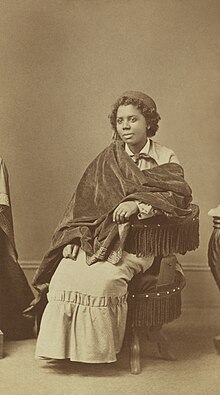The Crafting Freedom Project/Edmonia Lewis
The Life of Mary Edmonia Lewis

Mary “Edmonia” Lewis, known as Edmonia Lewis, was born c. 1845. Her mother was a Chippewa Indian who was married to an African-American man. Because her mother had free status, Lewis was born free. Historians are uncertain of her place of birth, but the most likely location is upstate New York (in or near Rensselaer County). After becoming an orphan at a young age, Lewis was raised primarily by her mother’s tribe. She briefly attended Oberlin College’s preparatory school for young girls when she was fourteen.
When she was eighteen, Lewis became acquainted with the abolitionist leader, William Lloyd Garrison. It is not clear how she came to know him, but he arranged for her to study under the neo-classical sculptor Edmund Brackett in Boston. Shortly thereafter, she opened her own studio in that city. The vast majority of Lewis’ work boldly reflects themes and subjects that were important to her as a free woman of color, such as heroes of the abolitionist movement and courageous women such as Cleopatra and Hagar, maid to Abraham's wife, Sara. Lewis’ marble bust of the leader of the all-black Fifty-Fourth Massachusetts Regiment of the Union army, Colonel Robert Gould Shaw, was so popular that she made replicas of it and used the proceeds to help compensate underpaid black Union soldiers. She also used this success to fund her expatriation to Rome. Two of Lewis’ portrait sculptures perhaps best exemplify how she “crafted freedom”. The first sculpture is of John Brown, the anti-slavery activist who led a raid against the United States government’s arsenal in a failed attempt to take up arms against slavery. The other work, titled “Forever Free, ” is a powerful sculpture based on the phrase in the Emancipation Proclamation, that “all persons held as slaves within any States, or designated part of the State, the people whereof shall be in rebellion against the United States, shall be then, thenceforward, and forever free.” It depicts a man sculpted in marble standing erect and looking upward. A broken chain dangles from his arm, which he holds upward. A woman kneels beside him and also looks upward. The man’s other arm is placed on the woman’s shoulder, suggesting that they are a couple and that he is protecting the woman. Some art historians think that this is a commentary on the fact that enslaved black men could not protect their women, but with emancipation, black men regained the manhood—and the ability to be protectors—that they had lost in slavery. However interpreted, it is a moving tribute and one whose imagery is transparent. Lewis clearly wanted it to be an inspiration for people who had experienced enslavement.
SELECTED BIBLIOGRAPHY ON EDMONIA LEWIS
PRIMARY SOURCES
Asleep, 1871.
Awake, 1872.
Bust of Lincoln, 1871.
Colonel Robert Gould Shaw, 187?
John Brown, 187?
The Death of Cleopatra, 1876.
SECONDARY SOURCES
Blodgett, Geoffrey. "John Mercer Langston and the Case of Edmonia Lewis: Oberlin, 1862" in Journal of Negro History. Vol. 53. July 1968, pp. 201-218.
Buick, Kirsten P. "The Ideal Works of Edmonia Lewis: Invoking and Inverting Autobiography" in American Art. Vol. 9. Summer 1995, pp. 5-19.
Burgard, Timothy Anglin. "Edmonia Lewis and Henry Wadsworth Longfellow: Images and Identities" in American Art Review. Vol. 7, no. 1, pp. 114-117.
Clark, Carolyn L. Edmonia Lewis (1843?-?), Sculptor, Her Elusive Life and Notable Career: A Selected Bibliography of Sources in the Auburn Avenue Research Library. 1997.
Hartigan, Lynda Roscoe. "Mary Edmonia 'Wildfire' Lewis." in Black Women in America: An Historical Encyclopedia. Ed. Darlene Clark Hine et al. 2 vols. Bloomington: Indiana University Press, 1993.
Lewis, Jo Ann. "An Afterlife for 'Cleopatra'" in The Washington Post. June 10, 1996, B1.
Reno, Dawn. Edmonia Lewis – The Sculptor they Called “Wildfire”. Books on Disk. CD-ROM. 2000.
Richardson, Marilyn. "Edmonia Lewis" in Harvard Magazine. Vol. 88. March-April 1986, pp. 40-41.
Richardson, Marilyn. "Edmonia Lewis's The Death of Cleopatra" in The International Review of African American Art. Vol. 12, no. 2 (1995): 36–52.
Wolfe, Rinna Evelyn. Edmonia Lewis: Wildfire in Marble. 2001.
Wreford, Henry. "A Negro Sculptress" in The Athenæum. Vol. 39. March 3, 1866.